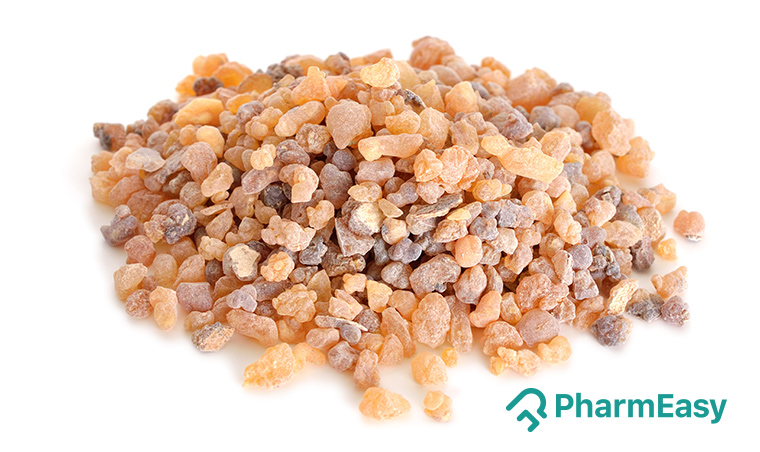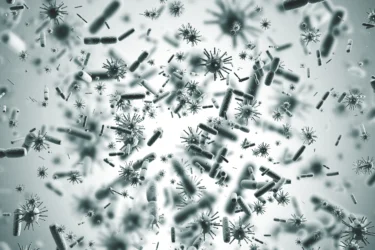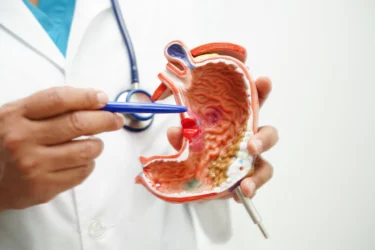Shallaki (Boswellia serrata): Uses, Benefits, Side Effects & More!
By Dr Siddharth Gupta +2 more

Get,

to manage your symptom
Get your,


4 Cr+ families
benefitted

OTP sent to 9988776655



You’ve successfully subscribed to receive
doctor-approved tips on
Whatsapp

Get ready to feel your best.

Hi There,
Download the PharmEasy App now!!


Register to Avail the Offer
Send OTPBy continuing, you agree with our Privacy Policy and Terms and Conditions

Hi There,
Sign up on PharmEasy now!!
Trusted by 4 crore+ families

OTP sent to 9988776655



You have unlocked 25% off on medicines




Code: NU25
By Dr Siddharth Gupta +2 more
Table of Contents
Shallaki is one of the ancient herbs in Ayurveda. It is significantly valued. Shallaki (Sanskrit) is also called Boswellia serrata, in botanical terms. It belongs to the Burseraceae family. It is a moderate-large-sized branching tree. The plant grows in the hilly region of India, the Middle East, and Northern Africa1.
In India, it is found in the dry hilly forests of Gujarat, Madhya Pradesh, Bihar, Rajasthan, Orissa, Assam, and central peninsular regions of Assam and Andhra Pradesh.

The oleo gum resin of Shallaki is used in various Ayurvedic and Unani preparations. Generally, it is used in making incense powder and sticks2.
The extract of Shallaki contains sugars, essential oil, volatile oil, terpenoids, and several pentacyclic triterpene acids like β-boswellic acid4.
Shallaki contains marked anti-inflammatory and anti-arthritic activity. It has antiseptic and astringent properties that might be beneficial in managing dysentery, piles, diarrhoea, ulcers, skin diseases, tumours, and genitourinary disorders. The oleo-gum resin of Shallaki contains boswellic acid that has analgesic, antitumor, and sedative properties3.





According to animal studies2, alcoholic extract of Shallaki exhibited anti-cancer activity by inhibiting the growth of tumours via the inhibition of cell proliferation and cell growth by interfering with the biosynthesis of protein, ribonucleic acid, and deoxyribonucleic acid.


The essential oil from the bark of Shallaki was studied against gram-positive and gram-negative bacteria.

The alcoholic extract of Shallaki improved the physical symptoms of dyspnoea, increase in stimulation of mitogen-activated protein kinase, number of attacks, and mobilisation of intracellular calcium in 70% of the patients with a prolonged history of asthma2.



I stumbled upon an interesting study that suggests Shallaki might be a fantastic natural option for tackling pain and inflammation. They conducted the study on rats and tested various extracts of Shallaki. And you know what they found? It turns out that Shallaki might have some impressive anti-inflammatory and analgesic effects8.
Dr. Siddharth Gupta, B.A.M.S, M.D (Ayu)
Also Read: Safed Musli – Uses, Benefits & Precautions
Generally, Shallaki is consumed as:
It is advisable to consult your physician before consuming Shallaki.
I found something fascinating about Shallaki. It appears that the resin extract from Shallaki might have shown some powerful properties in rats. It may act as both an anti-inflammatory and an antioxidant agent. But here’s the really exciting part: it might offer protection to certain neurons in the brain and may also improve motor impairments in Parkinson’s disease. These findings hint at the potential of Shallaki as a natural remedy for Parkinson’s disease9.
Dr. Rajeev Singh, BAMS
There are a few side effects observed with the utilisation of Shallaki. These are mostly mild and transient gastrointestinal symptoms like diarrhoea, nausea, or constipation4.
Also Read: Black Salt – Uses, Benefits & Side Effects
Keep the following points in mind:
I would recommend Shallaki if you’re dealing with cervical spondylosis. It might be a game-changer for you. A study was done on a group of people with cervical spondylosis, and they were given Shallaki capsules. Surprisingly, they experienced significant improvements. Their pain reduced, their flexibility increased, and even symptoms like headaches and numbness got better. The best part is that Shallaki was well-tolerated, with no reported side effects10.
Dr. Smita Barode, B.A.M.S, M.S.
Shallaki (Boswellia serrata) might interact with anti-neoplastic agents and leukotriene inhibitors6.
Also Read: Masoor Dal – Uses, Benefits & Precautions
Shallaki can be consumed as a capsule, tablet, or bark decoction1.
There is not sufficient data to support its use during breastfeeding; therefore, it is advisable to consult your doctor before consuming it.
Yes, Shallaki can be helpful for managing wounds as it exhibits wound-healing activity7.
Yes, it is safe to consume Shallaki due to its benefits, but patients consuming leukotriene inhibitors and anti-neoplastic agents should avoid consuming Shallaki6. Hence, it is advisable to consult a physician before taking Shallaki.
There is no sufficient data to support its safe use during pregnancy; therefore, it is advisable to consult your doctor before consuming it.
Shallaki has several benefits and is used to deal with diarrhoea, dysentery, piles, ulcers, skin diseases, tumours, and genitourinary disorders3.
Yes, it can be useful for managing arthritis as it was found to exhibit anti-arthritic effect in an animal model2.
Shallaki is also known as Salai, Kundur, Indian Olibanum, Frankincense, Dhup, Gugali, Saambraani, Phirangi, Parangi, Chitta, and Guguladhuph1,3.
Yes, Shallaki has been found to interact with leukotriene inhibitors and anti-neoplastic agents6.
Yes, Shallaki was found to improve the physical symptoms of dyspnoea, increase in stimulation of mitogen-activated protein kinase, number of attacks, and mobilisation of intracellular calcium in the patients with a prolonged history of asthma2.
Side effects of Shallaki include gastrointestinal symptoms like diarrhoea, nausea, or constipation4.
1. Siddiqui MZ. Boswellia Serrata, A Potential Antiinflammatory Agent: An Overview. Indian J Pharm Sci [Internet]. 2011 May [cited 2022 Feb 17];73(3):255. Available from: https://pubmed.ncbi.nlm.nih.gov/22457547/
2. Upaganlawar A, Ghule B. Pharmacological Activities of Boswellia serrata Roxb.-Mini Review. Ethnobot Leafl. 2009;13:766–74. Available from: https://www.researchgate.net/publication/200126782_Pharmacological_Activities_of_Boswellia_serrata_Roxb
3. Boswellia serrata — Vikaspedia. No Title [Internet]. Available from: https://vikaspedia.in/agriculture/crop-production/package-of-practices/medicinal-and-aromatic-plants/boswellia-serrata
4. Boswellia Serrata Herbal and Dietary Supplements. 2020;(Md). Available from: https://www.ncbi.nlm.nih.gov/books/NBK563692/
5. Vuddanda PR, Singh S, Velaga S. Boswellic acid – Medicinal use of an ancient herbal remedy. J Herb Med [Internet]. 2016;6(4):163–70. Available from: http://dx.doi.org/10.1016/j.hermed.2016.08.002
6. Posadzki P, Watson L, Ernst E. Herb-drug interactions: An overview of systematic reviews. Br J Clin Pharmacol. 2013;75(3):603–18. Available from: https://www.researchgate.net/publication/225274961_Herb drug_interactions_An_overview_of_systematic_reviews
7. Ghodela NK, Prasad P, Kumar V, Dudhamal T. Wound healing potential of gums & oleo-gum-resins: a brief review. Glob J Res Med Plants Indig Med [Internet]. 2017;6(January 2018):89–94. Available from: https://www.researchgate.net/publication/322717048_WOUND_HEALING_POTENTIAL_OF_GUMS_OLEO-GUM-RESINS_A_BRIEF_REVIEW
8. Sharma A, Bhatia S, Kharya MD, Gajbhiye V, Ganesh N, Namdeo AG, Mahadik KR. Anti-inflammatory and analgesic activity of different fractions of Boswellia serrata. Int J Phytomed. 2010;2(1):94-9. Available from: https://www.researchgate.net/publication/242721376_Anti-inflammatory_and_analgesic_activity_of_different_fractions_of_Boswellia_serrata
9. Doaee P, Rajaei Z, Roghani M, Alaei H, Kamalinejad M. Effects of Boswellia serrata resin extract on motor dysfunction and brain oxidative stress in an experimental model of Parkinson’s disease. Avicenna J Phytomed. 2019 May-Jun;9(3):281-290. PMID: 31143695; PMCID: PMC6526039. Available from: https://pmc.ncbi.nlm.nih.gov/articles/PMC6526039/
10. Pandey S, Kumar Y, Sharma A. Clinical evaluation of Shallaki Niryas (Boswellia serrata) in the management of Grivaasthi Sandhi Gata Vata (cervical spondylosis). Int Ayurvedic Med J. 2013;1(2):March-April. Available from: https://www.iamj.in/public/article/doi/4.pdf
Disclaimer: The information provided here is for educational/awareness purposes only and is not intended to be a substitute for medical treatment by a healthcare professional and should not be relied upon to diagnose or treat any medical condition. The reader should consult a registered medical practitioner to determine the appropriateness of the information and before consuming any medication. PharmEasy does not provide any guarantee or warranty (express or implied) regarding the accuracy, adequacy, completeness, legality, reliability or usefulness of the information; and disclaims any liability arising thereof.
Links and product recommendations in the information provided here are advertisements of third-party products available on the website. PharmEasy does not make any representation on the accuracy or suitability of such products/services. Advertisements do not influence the editorial decisions or content. The information in this blog is subject to change without notice. The authors and administrators reserve the right to modify, add, or remove content without notification. It is your responsibility to review this disclaimer regularly for any changes.
Comments

Leave your comment...
You may also like
Comments